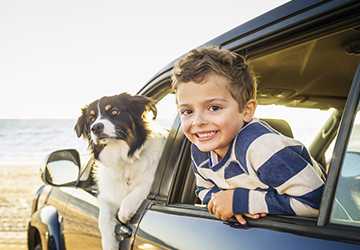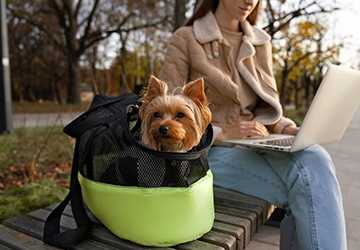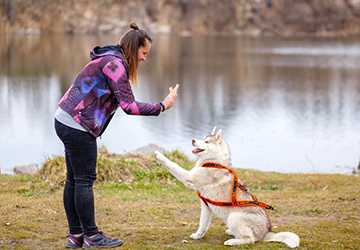Top 8 Tips for Traveling with Small Pets
Travelling with small pets can be an adventure filled with joy and bonding but also comes with challenges. Whether planning a road trip or taking to the skies, ensuring the comfort and safety of your furry friend should be a top priority. Here are practical tips to make your journey with your small pet smooth and enjoyable.

1. Choose the Right Carrier
The appropriate carrier for your small pet is crucial for a stress-free travel experience. Select a conveyance apparatus with commendable aeration, adept security features, and ergonomic comfort. Look for carriers with mesh sides to provide ample airflow and allow your pet to see their surroundings. Ensure the carrier is sturdy and escape-proof to prevent Houdini-style escapes during the journey.
About dimensions, opt for a conveyance apparatus that allows your pet to stand, pivot, and recline in a manner conducive to comfort. Soft-sided carriers are great for car travel, as they can be secured with a seatbelt, while hard-sided carriers offer extra protection during air travel.
Furthermore, acquaint your pet with the conveyance apparatus before the excursion, permitting them to acclimate within their familiar home environment. Leave the carrier open with a cosy blanket inside to create a positive association.
2. Pack Essentials for Comfort
Just like you pack your essentials, remember to gather items that will make your pet feel at ease during the journey. Include in your provisions your pet's preferred playthings, a recognizable blanket, and a selection of treats to engender a semblance of domesticity in an unfamiliar environment. Bringing along items with familiar scents can help alleviate stress and anxiety.
If you're travelling by car, secure the carrier in a well-ventilated area, away from direct sunlight. Use sunshades to protect your pet from excessive heat, and avoid leaving them unattended in a parked vehicle.
In the realm of air travel, communicate with the airline to elucidate the precise stipulations and prerequisites for the conveyance of pets. Certain carriers may proscribe specific types of carriers or mandate the procurement of a health certificate from a duly qualified veterinary practitioner.
3. Plan Regular Breaks
Extended voyages may induce weariness in both you and your diminutive companion. Take regular breaks to allow your pet to stretch, relieve physical needs, and rehydrate. Undertake research to identify rest stops or parks conducive to pet accommodation, ensuring a safe environment for exploration and the dissipation of excess energy.
During breaks, ensure your pet is on a leash or in a secure enclosure to prevent them from wandering off. Persistently engage in the meticulous removal of detritus ensuing from your quadrupedal companion and judiciously expunge waste materials in a manner befitting ecological stewardship. Facilitating the fortune and well-being of your domesticated creature during intermissions will engender an affirmative sojourn.
4. Prioritize Safety and Identification
The preeminent consideration during expeditions with diminutive animal companions resides in safety. Assiduously ascertain that your domesticated associate's identification particulars remain contemporaneous, including tags harbouring pertinent contact details and a collar impeccably tailored to its dimensions.
Moreover, deliberate on the potential implementation of microchipping for your pet as an additional stratum of security. In vehicular travel, utilize a robust harness or a secure carrier to constrain your pet, mitigating the likelihood of unimpeded movement within the vehicle.
It not only serves to shield your pet during sudden stops or manoeuvres but also curtails potential distractions for the driver. For air travel, follow airline guidelines for securing the carrier, and use identification labels to mark your pet's information.
5. Research Pet-Friendly Accommodations
Preceding the initiation of your odyssey, ascertain the hospitability of your accommodations towards including domesticated animals. While many hotels, motels, and vacation rentals extend their amenities to pet proprietors, the prudent course involves corroborating their stipulated animal policies in advance. Some places may have size or breed restrictions, and others might charge additional fees.
Seek accommodations endowed with amenities such as specially designated pet zones, meandering pathways conducive to pet perambulation, or even bespoke events tailored to the enjoyment of your companion animals, enhancing the overall experiential quality of your vacation.
6. Familiarize Yourself with Local Veterinary Services
Emergencies can happen, and it's essential to be prepared. Before embarking upon a vacation to uncharted territories, diligently delve into and record the contact details about indigenous veterinary services within the vicinity. Identify the nearest veterinary clinics or hospitals along your route, and have their phone numbers readily accessible.
Familiarize yourself with the location of 24-hour emergency veterinary services, just in case you encounter any health issues during non-business hours. Knowing where to turn in an emergency will provide peace of mind and swift assistance.
7. Gradual Acclimatization to Travel
Not all pets are natural-born travellers; some may need time to adjust to the new experience. Start with short trips around your neighbourhood before embarking on longer journeys to make the journey less stressful. This systematic process of gradual acclimatization facilitates the establishment of affirmative cognitive associations for your companion animal with the conveyance apparatus or vehicular environment, thereby effectively ameliorating anxiety levels during extended travel periods.

During these trial runs, observe your pet's behaviour and address any signs of discomfort or stress. If your pet seems nervous, offer treats, toys, or comforting words to create positive associations with the travel experience. This gradual approach will build your pet's confidence and make future travels more enjoyable for both of you.
8. Stay Calm and Patient
Ultimately, it sustains a serene and composed disposition throughout the expedition. Pets are highly attuned to their owner's emotions, and your demeanour can influence their experience. Speak to your pet in soothing tones, offer gentle reassurance, and avoid displaying signs of stress or frustration.
If your small pet shows signs of anxiety, such as pacing or excessive vocalization, take a moment to comfort them and provide a sense of security. Patience is vital, especially if your pet is adjusting to a new mode of transportation or environment. By staying calm and patient, you'll contribute to a positive atmosphere, making the journey a more pleasant experience for you and your furry companion.
Conclusion:
Travelling with small pets requires thoughtful planning and consideration, but the proper preparations can be a rewarding experience for you and your furry companion. By choosing a suitable carrier, packing essentials for comfort, planning regular breaks, and prioritizing safety and identification, you can create a stress-free and enjoyable journey for your small pet. So, buckle up, pack those treats, and embark on a memorable adventure with your pint-sized travel buddy!







